Have you ever noticed your skin acting up right after a night of indulging in greasy takeout or sugary treats?
Or may stress trigger those pesky breakouts?
Well, it’s not just your imagination!
Believe it or not, what’s going on inside your gut can have a surprisingly significant impact on the health and appearance of your skin.
That’s right, there’s a two-way street that connects your gut health and your skin health.
This connection, known as the gut-skin axis, is a fascinating area of research that’s changing the way we approach skincare.
Consider this your personalized guide to understanding this powerful connection, its science, and how to leverage it for a clearer, happier complexion.
The Gut Microbiome
Imagine a bustling metropolis within the body, teeming with trillions of tiny residents, including bacteria, yeast, fungi, and sometimes some protozoa.
This incredible universe, known as the gut microbiome, is more than just a collection of microscopic passengers; it’s a thriving ecosystem that plays a vital role in your overall health and well-being. (1)
These bacterial residents aren’t just hanging out for the free rent. They’re hard workers, contributing significantly to digestion.
They break down complex carbohydrates, fibers, and even some proteins that your body can’t process independently. This unlocks the essential nutrients in your food, making them readily available for your body to absorb.
But the gut microbiome’s impact goes far beyond digestion. These tiny tenants also play a crucial role in:
- Immune function
- Nutrient production
- Mood and mental health
But here’s the surprising thing: your skin has its unique microbiome, a complex ecosystem of bacteria, fungi, and other microbes living on its surface!
Like the gut microbiome, the skin microbiome plays a crucial role in your skin’s health and function.
Genetics, environment, and age influence your skin microbiome’s makeup. However, a healthy skin microbiome helps to: (2)
- Protect Against Pathogens: The good bacteria on your skin act as a natural defense system, helping to prevent harmful bacteria from taking hold and causing infections.
- Maintain Skin Barrier Function: A balanced skin microbiome helps maintain your skin’s natural moisture barrier, keeping it hydrated and supple.
- Promote Wound Healing: Certain bacteria in your skin microbiome play a role in healing, helping wounds close and repair themselves more efficiently.
Here’s the fascinating twist: the gut and skin microbiomes are constantly communicating with each other!
This two-way street, known as the gut-skin axis, plays a significant role in your overall health and well-being, especially your skin health.
The Gut-Skin Axis: A Two-Way Street
Imagine your gut and skin as two best friends who gossip constantly, but instead of juicy secrets, they exchange messages about your overall health.
This fascinating back-and-forth is called the gut-skin axis, and it’s much more than just idle chit-chat. (3)
It’s a complex communication network involving your immune, hormones, and nervous systems.
Here’s how it works:
The trillions of bacteria residing in your gut aren’t just busy with digestion; they also send signals throughout your body, including your skin.
When your gut microbiome is happy and balanced, it produces anti-inflammatory messengers that keep your skin calm and healthy.
But here’s the twist: if your gut gets disrupted by factors like stress, poor diet, or antibiotics, the conversation can worsen.
These disruptions can trigger the release of inflammatory signals that travel through your bloodstream, impacting your skin.
It’s like your gut bacteria are sending out distress calls, and your skin, unfortunately, bears the brunt of it.
This inflammation can manifest in skin conditions like acne, eczema, or rosacea.
The gut-skin axis also involves the gut’s influence on the immune system.
A healthy gut microbiome helps train your immune system to recognize and fight off harmful invaders. However, an imbalanced gut can lead to a hyperactive immune response, contributing to skin inflammation and irritation.
So, the next time you experience a skin flare-up, it might not just be a reaction to something you put on your skin; it could be a gut message letting you know things are out of balance.
How Gut Imbalances Show Up on Your Skin
A healthy gut microbiome is like a well-oiled machine, keeping things calm and running smoothly.
But when this balance gets disrupted, it can send distress signals throughout your body, impacting your skin in various ways. You might experience:
- Breakouts and Acne: Inflammation triggered by gut issues can produce excess oil and clogged pores, creating the perfect environment for pesky pimples. (4)
- Rosacea: This chronic skin condition, characterized by redness, bumps, and visible blood vessels, can be worsened by gut imbalances. (5)
- Eczema: This itchy, inflammatory skin condition can flare up due to a compromised gut barrier and an overactive immune response, potentially linked to gut issues. (6)
- Dryness and Sensitivity: A disrupted gut microbiome can affect your skin’s ability to retain moisture, leading to dryness and increased sensitivity. (7)
Remember, your skin reflects what’s happening inside. Addressing gut imbalance can calm internal chatter and promote a healthier, happier complexion.
Healing Your Gut for Glowing Skin
The good news?
You can transform your gut health and uncover the secrets to a clearer, happier complexion!
And here’s the best part: you don’t need drastic changes or complicated routines.
By incorporating these four simple steps into your daily life, you can start nurturing your gut and witness a positive transformation in your skin:
1. Embrace a Gut-Friendly Diet
Think of your gut bacteria as a picky bunch. They thrive on a diet rich in fiber-filled fruits, vegetables, and whole grains. These foods provide essential nourishment for your good gut bacteria.
Remember the healthy fats in avocados, nuts, and olive oil—they help keep your skin barrier strong and supple.
2. Consider Probiotics and Prebiotics
Consider incorporating probiotic-rich foods like yogurt, kimchi, sauerkraut, and kefir into your diet. These foods introduce live bacteria that can help replenish your gut with the good guys.
Additionally, prebiotic-rich foods like onions, garlic, asparagus, and apples provide the fuel your existing good bacteria need to thrive.
3. De-stress for a Happier Gut (and Skin)
We all know stress wreaks havoc on our lives, and your gut isn’t immune.
Chronic stress can negatively impact your gut microbiome.
Activities like yoga, meditation, or simply spending time in nature can help manage stress and create a more peaceful environment for your gut bacteria to flourish.
4. Stay Hydrated
Just as plants need water to thrive, gut bacteria need proper hydration to work their magic.
A simple rule for adequate hydration is to take your weight in pounds (lbs) and divide by 2. This will give you the ounces of water you should consume daily.
Example: A 140 lb person would ideally aim for 70 ounces of water daily. 140lbs /2 = 70 ozs
Ready to Uncover the Secrets to Clear, Radiant Skin?
These simple steps are a powerful starting point for improving your gut health and achieving a glowing complexion.
However, proper skin health is a journey; sometimes, you need a guide.
Are you ready to ignite your skin’s natural radiance?
Grab your FREE ebook on Unlock Clearer Skin: 10 Pillars of Functional Dermatology You Need to Know.
Skin Wellness Providers and Aestheticians: Deepen your knowledge of the gut-skin connection with a certification in Microbiome nutrition and Skin -Gut axis!! Schedule a consultation to learn how a workshop on this topic can elevate your practice.
Resources
1. “Role of the normal gut microbiota – PMC.” NCBI, https://www.ncbi.nlm.nih.gov/pmc/articles/PMC4528021/. Accessed 10 April 2024.
2. Grice, Elizabeth A., and Julia A. Segre. “The skin microbiome – PMC.” NCBI, https://www.ncbi.nlm.nih.gov/pmc/articles/PMC3535073/. Accessed 10 April 2024.
3. “Gut–Skin Axis: Current Knowledge of the Interrelationship between Microbial Dysbiosis and Skin Conditions.” NCBI, 11 February 2021, https://www.ncbi.nlm.nih.gov/pmc/articles/PMC7916842/. Accessed 10 April 2024.
4. Byun, Eun Jung. “Potential Role of the Microbiome in Acne: A Comprehensive Review.” NCBI, 7 July 2019, https://www.ncbi.nlm.nih.gov/pmc/articles/PMC6678709/. Accessed 10 April 2024.
5. “Role of the skin microbiota and intestinal microbiome in rosacea.” NCBI, 10 February 2023, https://www.ncbi.nlm.nih.gov/pmc/articles/PMC9950749/. Accessed 10 April 2024.
6. “The Intestinal and Skin Microbiome in Patients with Atopic Dermatitis and Their Influence on the Course of the Disease: A Literature Review.” NCBI, 6 March 2023, https://www.ncbi.nlm.nih.gov/pmc/articles/PMC10001192/. Accessed 10 April 2024.
7. “Impact of gut microbiome on skin health: gut-skin axis observed through the lenses of therapeutics and skin diseases.” NCBI, 22 July 2022, https://www.ncbi.nlm.nih.gov/pmc/articles/PMC9311318/. Accessed 10 April 2024.




